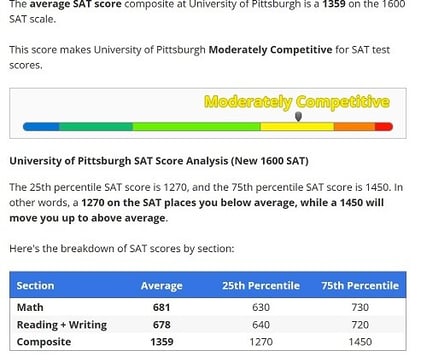
Planning to take the SAT soon? Then you're probably wondering, "What's a good SAT score for 2025?" In this in-depth guide, we break down three different ways you can define good SAT scores for 2025. Then we’ll show you how to figure out the SAT score you need to meet your goals.
Let's get started!
What's a Good SAT Score 2025 Overall?
In simplest terms, a good overall SAT score is one that's considered high compared to the scores of other students who took the test. An easy rule of thumb is that any SAT score that places you in the top half of test takers is good. The higher your score is above average, the better. Similarly, SAT scores that place you in the bottom half of test takers are considered not so good. To determine how your SAT scores compare to others' scores, we'll need to look at SAT averages and percentiles from the past year.
According to the most recent College Board data, the average SAT score for 2024 is 1024 (out of 1600). The average score for the Math section is 505, whereas the average score for the Evidence-Based Reading and Writing (ERW) section is 519.
This means that a good SAT score is any score above 1024.
We can also use percentiles to determine what a good SAT score is. Remember, a percentile tells you what percentage of other test takers you scored the same as or better than on the SAT. For example, a 76th percentile score means you scored the same as or better than 76% of test takers.
The following chart tells you more specifically what SAT scores can be considered poor, good, and great. We used 2024 percentile data from the College Board to make this chart based on students who graduated in 2024.
|
Percentile
|
Reading & Writing
|
Math
|
Total Score
|
|
99th (Best)
|
760 and above
|
790 and above
|
1530 and above
|
|
90th (Excellent)
|
680
|
690
|
1360
|
|
75th (Good)
|
610
|
590-600
|
1200
|
|
50th (Average)
|
520
|
510
|
1030
|
|
25th (Poor)
|
440-450
|
420-430
|
870
|
|
10th (Poorer)
|
390
|
370
|
770
|
|
1st (Poorest)
|
320 and below
|
300 and below
|
660 and below
|
Source: The College Board
Looking at the chart, you can see that you only need to score 1360 on the SAT to be within the top 10% of test takers. That means that a perfect 1600 isn't required to get an excellent score! You don't even need to break 1400!
A score of 770 or below puts you in the bottom 10% of test takers and won't look very strong on college applications. Even if you managed to raise your score from 770 to 870, you'd still be in the bottom 25%, meaning that three-quarters of students did better than you on the SAT. As a result, we can say that any SAT score at or below the 25th percentile is poor.
However, percentiles aren't the only factor to consider when it comes to determining a good SAT score. You'll need to also pay attention to how strong your scores are for the specific colleges you're applying to.
What's a Good SAT Score 2025 for You?
Ultimately, what's most important when it comes to good SAT scores isn't what percentile you're in, but whether your score is high enough to get you into your dream college. At PrepScholar, we call this your SAT goal score. It's the score that's most likely to get you admitted to the schools you're applying to. Hit your goal score, and you'll have a great shot at attending your top-choice college!
How high your own goal score is will depend on the schools you're applying to. For example, if you were applying to extremely competitive Ivy League-level schools, such as Stanford and MIT, your goal score would be really high—right around a perfect 1600. But if you were looking at less competitive schools like University of Iowa, then you'd aim for something closer to around 1310.
To determine your own SAT goal score for 2025, you'll need to know what SAT scores admitted students typically get at each of the colleges you're applying to. Then, set your score target equal to or greater than the highest average score on your school list. That'll give you the best chance of being accepted at each of the schools you're applying to.
3 Steps to Choosing Your SAT Goal Score for 2025
To find your SAT goal score for 2025, follow these three steps:
Step 1: Make a Schools Chart
Your first step is to make a chart that includes the name of each school you’re applying to and the 25th percentile and 75th percentile scores for each school’s admitted students. You can make the chart yourself, or download ours by clicking the thumbnail below.
When creating your chart, be sure to include your match schools and reach schools. You can exclude safety schools, since you already know that you’re likely overqualified for acceptance to those colleges!
Here’s a sample chart with several schools already filled in:
|
School Name
|
25th Percentile SAT Score
|
75th Percentile SAT Score
|
|
Penn State
|
||
|
Juniata College
|
||
|
Villanova University
|
||
|
University of Pittsburgh
|
Step 2: Find SAT Score Ranges for Your Schools
The next step is to do some online research to find the SAT information for each school. Specifically, you'll want to look for the middle 50%, or average, range of SAT scores—i.e., the 25th and 75th percentile scores—for each school.
The easiest way to do this is to use our PrepScholar college database. Simply search for "[School Name] PrepScholar" or "[School Name] PrepScholar SAT" and then click the link to the school's page in either our SAT/GPA or admissions databases.
Once you've clicked the link to that school's page in one of our databases, scroll down to find the SAT score information for that school. You'll need the 25th and 75th percentile scores.
Here's an example of what this page looks like for the University of Pittsburgh:

As you can see, the 25th percentile composite score for the University of Pittsburgh is 1270, and the 75th percentile score is 1450. This comes out to an average composite score of 1360. Record the 25th and 75th percentile composite SAT scores in your chart. Repeat this process for every school you're applying to.
If you can't find your school in our PrepScholar database, go to your school's official website and look for any information it has on student facts and figures, admissions data, etc. You might also try searching for "[School Name] average SAT scores" or "[School Name] SAT scores" and looking for links to your school's official website.
By the end, your chart should look like this:
|
School Name
|
25th Percentile SAT Score
|
75th Percentile SAT Score
|
|
1230
|
1390
|
|
|
1070
|
1280
|
|
|
1380
|
1500
|
|
|
1270
|
1450
|
Step 3: Determine Your Goal Score
Now that you have your school chart complete, it’s time to figure out your goal score! To do this, find the highest 75th percentile score in your chart. This will be the SAT score you’re going to aim for because it’s the most likely to get you accepted to all the schools in your list.
In the chart above, the highest 75th percentile score is 1500 for Villanova University. This means that your goal score will be a prestigious 1500, which is in the 98th percentile of all test takers!
If you’re worried that your goal score will be difficult to achieve, you can lower your goal slightly to a score that’s between the highest and second-highest 75th percentile scores in your chart, or to your second-highest 75th percentile score. Using our sample chart, the second-highest 75th percentile score would be 1450 for the University of Pittsburgh, which is in the 96th percentile.
Once you've got your goal score for the SAT, you can divide this score in half to get your rough scores to aim for on the Math and Reading & Writing sections. In our example, this would be 1500 ÷ 2 = 750, which means you'd want to aim for a score of about 750 on each section.
How Do New Test Score Policies Affect What’s a Good SAT Score 2025?
Over the past several years, and especially since COVID-19, many schools have changed their admissions policies regarding SAT/ACT scores, either temporarily or permanently. Some schools have adopted test optional admission policies which means that test scores aren't required to apply. Schools with test-optional policies allow you to choose whether you submit your SAT scores.
How do test-optional policies affect you as you set your SAT goal score? The main way is that they may make it more difficult to track down the most recent SAT score percentiles and averages for some schools. Many schools that have implemented test-optional admissions no longer release their admitted students’ SAT scores, which can make it tough to determine what your goal scores should be.
To learn more about how these changes may affect you, check out our article on how test optional policies affect the significance of SAT/ACT scores in college admissions.

What Is a Good SAT Score 2025 Compared To Past Years?
Now that we’ve gone over different ways to determine good SAT scores, let's look at how average SAT scores from 2025 compare to past years' scores. Are good SAT scores for this year the same as good SAT scores for past testing years?
In short, yes! Good SAT scores don’t change much from year to year; however; there are some fluctuations over time.
Here are SAT averages from 2017 through 2024:
|
Year
|
Avg ERW
|
Avg Math
|
AVG TOTAL
|
|
519
|
505
|
1024
|
|
|
520
|
508
|
1028
|
|
|
529
|
521
|
1050
|
|
|
533
|
528
|
1060
|
|
|
528
|
523
|
1051
|
|
|
531
|
528
|
1059
|
|
|
536
|
531
|
1068
|
|
|
533
|
527
|
1060
|
As the chart above shows, average SAT scores have not changed drastically, but we can see a dip beginning in 2023. This may be due to lingering effects of school closures due to COVID-19 and/or the beginning of the shift to the digital SAT. Whatever the cause, the change is still fairly minimal.
We also have to look at percentiles. The chart below shows current and past SAT percentiles for 2017 through 2024:
|
Year
|
90th %ile
|
75th %ile
|
50th %ile
|
25th %ile
|
10th %ile
|
|
1360
|
1200
|
1030
|
870
|
770
|
|
|
1350
|
1200
|
1040
|
870
|
780
|
|
|
1350-1360
|
1200
|
1040
|
890
|
780
|
|
|
1350
|
1200-1210
|
1040-1050
|
890-900
|
780
|
|
|
1340
|
1200-1210
|
1050-1060
|
910
|
800
|
|
|
1340
|
1200-1210
|
1050-1060
|
910
|
800
|
|
|
1340
|
1200-1210
|
1050-1060
|
910-920
|
800
|
|
|
1320-1330
|
1190-1200
|
1050-1060
|
910-920
|
800-810
|
From looking at the chart above, we can see that percentiles haven't changed much over the past five years. In fact, from one year to the next, the score ranges don’t shift more than 20 points in each percentile.
It’s tough to predict how SAT score averages and percentiles will change from year to year, but because these numbers have not changed a ton, we can say that the definition of a good SAT score hasn’t changed a lot since 2017. And that will probably be true for a while!
Summary: What's a Good SAT Score for 2025?
There are three main ways you can define good SAT scores for 2025.
One way is to look at the national average, which is 1024. Any score above this threshold can be considered a good score, as it means you've done better than the majority of test takers.
Another way of defining good SAT scores is to look at SAT score percentiles, which compare your performance with those of other test takers. The higher your percentile, the better you did relative to other students. In general, scores in the 50th percentile (1030) are average, while scores in the 75th percentile (1200) and 90th percentile (1360) are good and excellent, respectively.
The last (and by far most important!) way you can define good SAT scores for 2025 is to figure out what scores are good for you based on the schools you're applying to. Look for SAT score data for each of your schools; the highest 75th percentile score will be your target score—that is, what's considered a good score for you and you alone.
Once you know what score to aim for on the SAT, you can get started on coming up with your very own SAT study plan!
What's Next?
Now that you've figured out your SAT goal score, it's time to start studying. The best place to start is with our ultimate guide to the SAT. It'll introduce you to the test, give you study tips, and set you up for improving your score.
Once you've got the basics down, it's time to start practicing. One of the best tools in your arsenal is the free SAT practice tests that are available online. These will help you test your skills in real time and adjust your study habits to target your weakest areas.
Of course, you can also get some expert help, too. PrepScholar's Complete Online Digital SAT Prep program is guaranteed to boost your SAT score. That way, you'll have a better chance of getting into your dream school.













